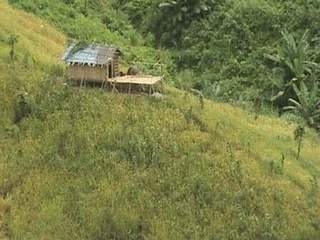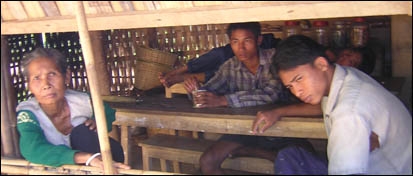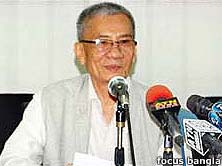Bangladeshi hill region turns into ‘death valley’: Tribesmen accuse Santu Larma
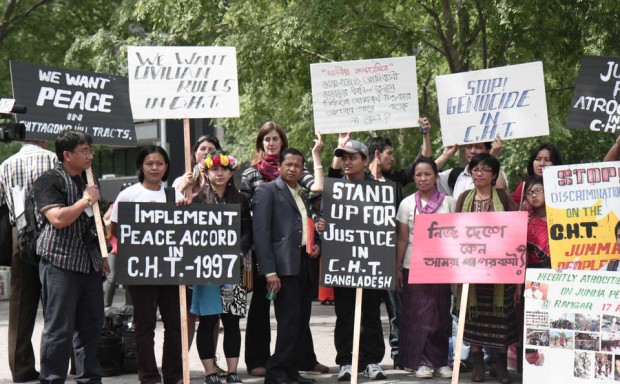
Jummas and indigenous people from around the world call for the Chittagong Hill Tract peace treaty to be honored outside the UN headquaters.
Bangladesh’s much talked about Chittagong Hill Tract peace treaty signed in 1997 between the then government of Sheikh Hasina and Parbatya Chattagram Jana Sanghati Samity (PCJSS) led by Santu Larma have been failing to bring peace in the hills. Apart from the conflict between the Hillmen and the settler Bengali community over land rights, the peace treaty itself has created a new dimension of conflict among the tribal community.
The Chittagong Hill Tracts Peace Accord is a political agreement and peace treaty signed between the Bangladeshi Government and the PCJSS, the political organisation that controlled the armed Shanti Bahini militia group. The accord allowed for the recognition of the rights of the peoples and tribes of the Chittagong Hill Tracts region and ended the decades-long insurgency between the Shanti Bahini and government forces.
The agreement recognised the distinct ethnicity and special status of the tribes and indigenous peoples of the Chittagong Hill Tracts, and established a Regional Council consisting of the local government councils of the three districts of the Hill Tracts.
The agreement also provided for the setting up of a central Ministry of Tribal Affairs to be headed by a person of tribal ethnicity to administer the affairs concerning the Hill Tracts.[4] The agreement also laid out plans for the return of land to displaced natives and an elaborate land survey in the Hill Tracts.
Howevcer, differences developed among the tribal community on the very content and the question of implementation of Peace Treaty. The indigenous national community living in the three hill districts are now sharply divided in three major groups- JSS Santu Larma group, JSS Manobendra Larma group and United Peoples’ Democratic Front (UPDF).
Due to infighting among the tribal groups, Chittagong Hill Tracts have virtually turned into a death trap as killings go on unabatedly mostly in Khagrachari and Rangamati hill districts. At least eight indigenous leaders were gunned down and two leaders – Adarshon Chakma and Babu Chakma – sustained gunshot injuries in separate incidents over the last three weeks .
The deceased leaders belonged to three organisations – Santu Larma led Parbattya Chattagram Jana Sanghaty Samity (PCJSS), its faction Parbattya Chattagram Jana Sanghaty Samity (MN Larma group) and the United Peoples’ Democratic Front (UPDF)
Due to the ongoing factional clash on June 29, Panchhari Upazila PCJSS (MN Larma group) General Secretary Supon Chakma alias Sagor Badsha was killed. In an attack on July 2, PCJSS (MN Larma group) leader Mithun Chakma, 28, was gunned down in Merung Bazar area under Dighinala upazila .
Similarly, UPDF leader Samiron Chakma, 34 and PCJSS (MN Larma) leader Jarman Chakma alias Purna Chakma were gunned down on July 4 at Pujgung under Panchhari upazila. PCJSS (Santu Larma group) leader Umong Marma, 50, was shot dead on July 5 at Kumary Tintohori Para under Manikchhari upazila.
Pastor (chief) of Tapitapara Christain Church Arun Kanti Chakma, 40, was killed at Tapita Para under Panchhari upazila and another PCJSS (MN Larma group) leader Anjoy Chakma, 35, was shot dead at Ultachhari village under Dighinala upazila in Khagrachhari.
In another assualt, Thowaicha Ching Marma, 40, a leader of Santu Larma led PCJSS , was gunned down at Agorpara under Kaptai upazila in Rangamati on July 14. UPDF Press Secretary Niron Chakma blamed their rival PCJSS (Santu Larma) group for the killings.
Condemning the killings, Niron Chakma also urged the district administration to arrest Santu Larma saying that he is the mastermind behind the killings, abductions, lootings and all sorts of criminal activities in the CHT region. PCJSS (MN-Larma group) Khagrachhari district unit General Secretary Bibu Ranjon Chakma also blamed the Santu Larma led fraction for the killings. He urged law enforcers to take actions against the killers.
Assistant Secretary of PCJSS (Santu Larma group) Sajib Chakma denied their involvement in the killings. Blaming UPDF for the killings, Sajib urged the government to ban UPDF considering its criminal and anti-state activities.
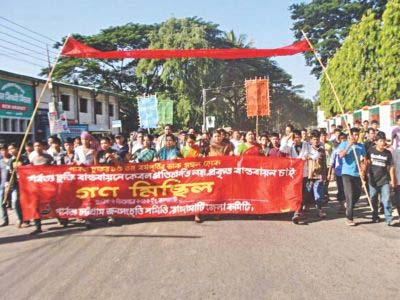
Parbatya Chattagram Jana Sanghati Samity (PCJSS) brought out a big procession in Rangamati district town marking the 15th anniversary of CHT peace treaty.
However, police administration believe that the recent killings took place over establishing supremacy in the hill districts. In most of the cases, family members of the victims were not interested file any case. Most of the time the police file cases but found it difficult to prove the cases, as they could not find any witness.
The overall situation in the hills has turned tense and dangerous for the indigenous community due to infighting among the warring factions, UPDF leader Mithun Chakma said. According to Mithun the people of the three hill districts are not allowed to enjoy political or democratic rights while the present conflicts are affecting the social, economic and cultural life of the tribal community.
UPDF Leadership held Sontu Larma as the main trouble maker and also responsible for instigating killings and violence by deploying his armed goons. Santu’s armed group is doing what the military used to do earlier in the hills, says UPDF Leader Sumen Chakma.
Santu, after assuming the CHT Regional Council , has become a partner of the government in blocking the way for peace in the hills, according to UPDF and JSS (ML) leaders. Both UPDF and JSS (ML) believe that a sustained peace can be achieve by removing Santu from Regional Council, withdrawing army from CHT and rehabilitating the Bengali settlers to plain land out of hill tracts. автокредит на бу автомобиль





















